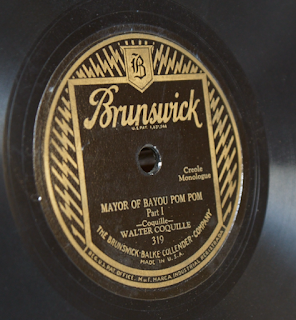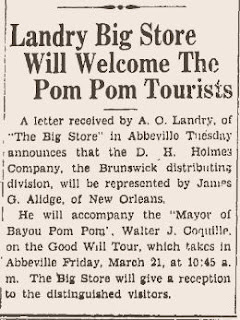Oh, c'est malheureux chère
c'est malheureux te voir, autant dans les douleurs.
Oh, c'est tout le temps dur à ton pop,
ta mom t'a donnée là, je vas jamais oublier ça.
Oh, rapelle-toi, donc, de la fois
J'étais t'amener sur le pont,
Sur le pont du Bayou Pon Pon
"Oh toi t'es la seule, maman,"
Ça dit à toi, catin
Ça me fait du mal à moi.
Oh, c'est misérable aujourd'hui
Si t'es à la traîne comme ça,
Dans les chemins, toi, toute seule,
Oh, savoir qui c'est l'auteur
Oh, si t'es comme ça aujourd'hui,
C'est pas la peine tu me blàmes.
 |
| "Red River" Dave Mcenery, Bob Tanner (holding a record), Ray Campi, Ray Liberto |
Bayou Pon Pon (spelled either "Pon Pon" or "Pom Pom") is a mythical town, somewhere in Lafourche Parish, in which comedian Walter Coquille would use as the basis for his 1929 satirical recordings. In Iry's 1953 version of the song, he spoke of the sorrow of a loved one he remembers at the Bayou Pon Pon bridge. Other men want her stating, "Oh toi t'es la seule, maman", but he's convinced she'll be alone if he can't have her. According to Ron Yule's interview with Milton and Odile Vanicor, the song revolves around Adeline Blanchard's visits with Iry, sitting a bridge, in which she asked him to write a song about a bridge.
 |
| Iry Lejeune |
Iry had his crack band called the Lacassine Playboys that featured fiddle player Milton Vanicor. For this session though, Eddie brought his tape recorder to Iry's home, grabbed his guitar, and the trio recorded into the night. For some reason, Ed didn't release this on the Goldband or Folk-Star label. Eddie Shuler recalls working with Bob Tanner, owner and founder of the TNT label:
Well, I went to San Antonio because Bob Tanner had a pressing plant. So, I drove over there, and took a couple of my acetates with me. And I told him I’d like to make a deal for him to press my records. So, he decided he’d press ‘em himself and put ‘em on his label. And I said, "Well, okay, let’s try that." I hadn’t tried that.
Oh, it's sad, dear,
It is sad to see you in pain,
Oh, its always so hard for your pop.
Your mom gave you away there,
I'll never forget that.
Oh, reminds me of that time,
I took you to the bridge,
Oh, the Bayou Pon Pon bridge.
"Oh you're the only one, little mama,"
That's what they said, my doll,
It hurt me.
Oh, today is miserable,
If you're running down,
Along the road, all alone,Oh, to know who is at fault,Oh, if you're still like that today,It's no use to blame me.
Although Bob's primary goal was to record and press more Tex-Mex music eventually including rockabilly, country, blues, jazz, and polka, he had pressed only three Cajun records and didn't seem to have had any sort of guiding vision like Pappy Daily or other independent labels in Texas. It was short lived.
- Iry Lejeune: Wailin the Blues Cajun Style by Ron Yule
- South to Louisiana: The Music of the Cajun Bayous By John Broven
- http://wired-for-sound.blogspot.com/2011_11_24_archive.html
- http://wired-for-sound.blogspot.com/2010/06/jerry-dove-on-tnt-122.html
- SENATE CONCURRENT RESOLUTION NO. 15. 2015 Regular Session. Notes to commend Milton Vanicor for his passion, devotion, and his nearly eighty-year commitment to Cajun music.
Find:
Louisiana Cajun Music Volume 4: From The 30s To The 50s (Old Timey, 1972)
The Legendary Iry LeJeune (Goldband, 1991)
Cajun's Greatest: The Definitive Collection (Ace, 2004)























